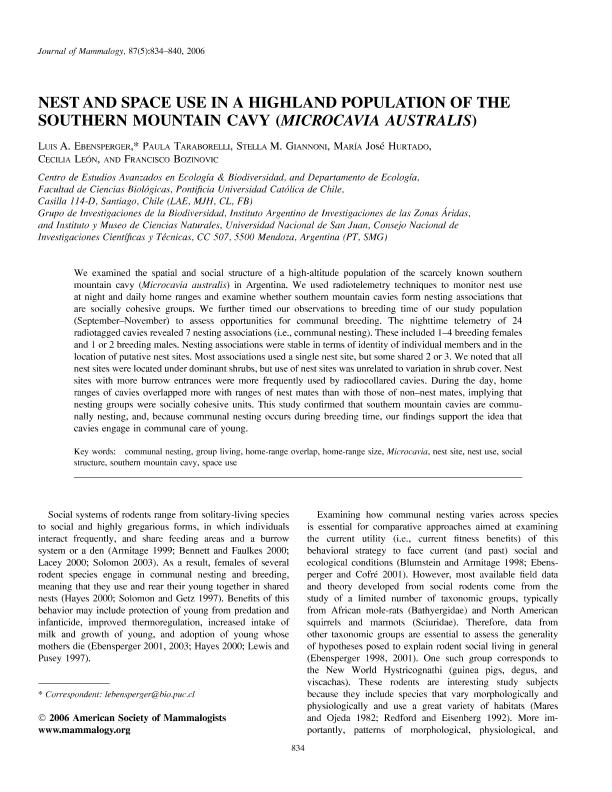Artículo
We examined the spatial and social structure of a high-altitude population of the scarcely known southern mountain cavy (Microcavia australis) in Argentina. We used radiotelemetry techniques to monitor nest use at night and daily home ranges and examine whether southern mountain cavies form nesting associations that are socially cohesive groups. We further timed our observations to breeding time ofour study population (September–November) to assess opportunities for communal breeding. The nighttime telemetry of 24 radiotagged cavies revealed 7 nesting associations (i.e., communal nesting). These included 1–4 breeding females and 1 or 2 breeding males. Nesting associations were stable in terms of identity of individual members and in the location of putative nest sites. Most associations used a single nest site, but some shared 2 or 3. We noted that all nest sites were located under dominant shrubs, but use of nest sites was unrelated to variation in shrub cover. Nest sites with more burrow entrances were more frequently used by radiocollared cavies. During the day, home ranges of cavies overlapped more with ranges of nest mates than with those of non–nest mates, implying that nesting groups were socially cohesive units. This study confirmed that southern mountain cavies are communally nesting, and, because communal nesting occurs during breeding time, our findings support the idea that cavies engage in communal care of young. Examinamos la estructura espacial y social de una población andina del cuis chico (Microcavia australis) en Argentina. Utilizamos radiotelemetría para cuantificar el uso de madrigueras durante la noche, el ámbito de hogar durante el día, y verificamos si los grupos comunitarios identificados (individuos que anidan juntos) establecen unidades sociales cohesivas. Las observaciones se realizaron durante el período reproductivo para evaluar además la potencialidad de que exista reproducción cooperativa. El seguimiento nocturno de 24 cuises marcados con radiocollares permitió detectar siete asociaciones comunitarias compuestas por 1–4 hembras reproductivas y entre 1 o 2 machos reproductivos. Las asociaciones detectadas fueron estables en términos de la composición de sus integrantes así como de la ubicación de las madrigueras utilizadas. La mayor parte de las asociaciones usaron una madriguera pero algunas usaron 2 o 3. Todas las madrigueras estaban localizadas bajo la cobertura de arbustos. Cada cuis utilizó más aquellas madrigueras con un mayor número de entradas. Durante el día, el ámbito de hogar de cada cuis se sobrepuso más con el de cuises de la misma asociación y menos con los de cuises de otras asociaciones. Nuestro estudio confirmó que M. australis comparte sus madrigueras comunitariamente, que estas asociaciones tienden a ser estables, socialmente cohesivas, y muy probablemente, que los adultos realizan cuidado cooperativo de sus crías.
Nest and space use in a highland population of the southern mountain cavy (Microcavia australis)
Ebensperger, Luis A.; Taraborelli, Paula Andrea ; Giannoni, Stella Maris
; Giannoni, Stella Maris ; Hurtado, María José; León, Cecilia; Bozinovic, Francisco
; Hurtado, María José; León, Cecilia; Bozinovic, Francisco
 ; Giannoni, Stella Maris
; Giannoni, Stella Maris ; Hurtado, María José; León, Cecilia; Bozinovic, Francisco
; Hurtado, María José; León, Cecilia; Bozinovic, Francisco
Fecha de publicación:
10/2006
Editorial:
Alliance Communications Group Division Allen Press
Revista:
Journal of Mammalogy
ISSN:
0022-2372
Idioma:
Inglés
Tipo de recurso:
Artículo publicado
Clasificación temática:
Resumen
Archivos asociados
Licencia
Identificadores
Colecciones
Articulos(CCT - SAN JUAN)
Articulos de CENTRO CIENTIFICO TECNOLOGICO CONICET - SAN JUAN
Articulos de CENTRO CIENTIFICO TECNOLOGICO CONICET - SAN JUAN
Articulos(IADIZA)
Articulos de INST. ARG DE INVEST. DE LAS ZONAS ARIDAS
Articulos de INST. ARG DE INVEST. DE LAS ZONAS ARIDAS
Citación
Ebensperger, Luis A.; Taraborelli, Paula Andrea; Giannoni, Stella Maris; Hurtado, María José; León, Cecilia; et al.; Nest and space use in a highland population of the southern mountain cavy (Microcavia australis); Alliance Communications Group Division Allen Press; Journal of Mammalogy; 87; 5; 10-2006; 834-840
Compartir
Altmétricas



